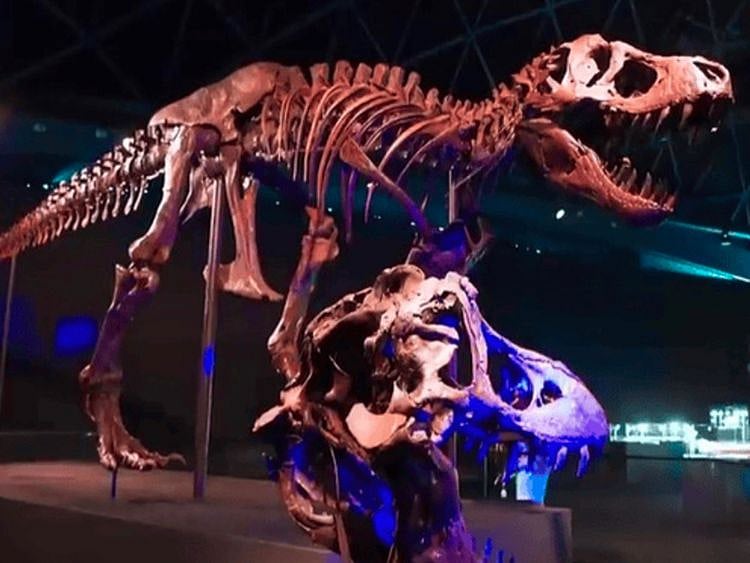From dinosaurs to secrets from space: Abu Dhabi’s Natural History Museum's treasures revealed
New cultural landmark promises to redefine understanding of the natural world

Abu Dhabi: A magnificent new home for natural history is taking shape in the UAE’s capital. Scheduled for completion next year, the Natural History Museum Abu Dhabi promises to be a groundbreaking cultural landmark that will redefine how one understands the natural world.
Located in the Saadiyat Cultural District, the museum will span more than 35,000sqm and feature rare specimens from across the globe. It aims to provide immersive experiences that deepen our knowledge of the planet’s evolution.
Gulf News got an exclusive preview of some of the wonders that will be on display, including dinosaurs, animals and marine life native to the Arabian Peninsula.
Age of dinosaurs
Visitors can discover the story behind the white jaw of a Hadrosaur, a duck-billed herbivorous dinosaur that lived about 66 million years ago – at the close of the Cretaceous period, which marked the extinction of the dinosaurs. The fossil, which illustrates the different feeding habits and life of the period, will be displayed in the museum’s Palaeo Lab, a space dedicated to younger visitors. Interestingly, Hadrosaur fossils have been found in the Arabian Peninsula as well.
Another attraction is the fossilised remains of a 67-million-year-old Tyrannosaurus rex, one of the most iconic apex predators. Popularised by Steven Spielberg’s 1993 blockbuster Jurassic Park, the T. rex remains are sure to captivate museum-goers. In addition, a Stegosaurus, a 150-million-year-old armoured dinosaur with bony plates along its back and spikes on its tail, will be displayed in the ‘Dawn of the Dinosaurs’ section.
Other treasures include the fossil of a seven-million-year-old four-tusked Arabian elephant that roamed Abu Dhabi when rivers, savannas and forests dominated the landscape. Scale models of other animals and marine creatures, will also be featured.
Secrets of solar system
Visitors can embark on a 13.8-billion-year journey through time and space, featuring objects as ancient as our solar system. Highlights include the Murchison Meteorite, which contains grains more than 7 billion years old, offering insights into the origins of life on Earth.
A space exploration gallery will present the Voyager interstellar recordings commissioned by NASA in 1974. The ‘Murmurs of Earth: The Voyager Interstellar Record’ is a message intended for any distant civilisations that might encounter the two spacecraft launched by NASA. The gallery will include the Sputnik Activation Key and Logbook, created by the Soviet Union’s space agency.
More than a museum
“Rather than just showcasing specimens, artefacts and reading panels, the museum’s galleries will be highly engaging and interactive, which children will love,” Noora Abdulla Albalooshi, assistant curator, told Gulf News. “We will also have a theatre area where we can give talks and show films to explain to kids how amazing the natural world is and the role they can play in it.”
The museum will highlight Abu Dhabi’s coast, home to rich marine life, an area of particular interest to Noora, who grew up spending time with her fisherman grandfather along the UAE’s shores. Noora is currently conducting an acoustic study on the distribution and interaction of three marine mammal species native to local waters.
Young scientists like Noora are drawn to the museum as an institution rooted in research and education. With state-of-the-art laboratories and a growing collection, the museum will become a vibrant centre for scientific knowledge, engaging visitors across generations.
Creating a legacy
In addition to the Natural History Museum Abu Dhabi, the Saadiyat Cultural District will house the Zayed National Museum, teamLab Phenomena Abu Dhabi, and the Guggenheim Abu Dhabi.
Mohamed Khalifa Al Mubarak, Chairman of the Department of Culture and Tourism – Abu Dhabi, emphasised that through this cultural district, the capital city is creating a legacy that will inspire future artists, curators, writers, and architects worldwide.
“The district’s institutions are pivotal in educating our youth through direct interaction with our cultural institutions. They spark curiosity, foster critical thinking, and cultivate creativity, serving as platforms for lifelong learning,” Al Mubarak added.
Sign up for the Daily Briefing
Get the latest news and updates straight to your inbox
Network Links
GN StoreDownload our app
© Al Nisr Publishing LLC 2025. All rights reserved.